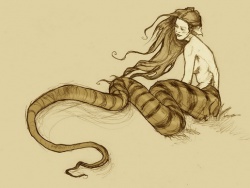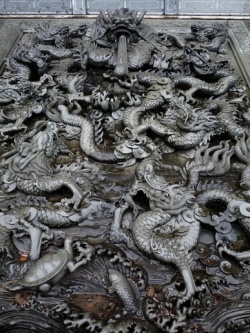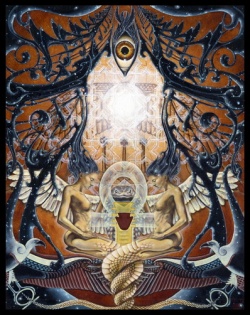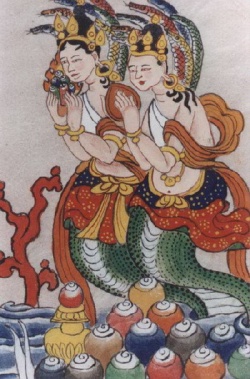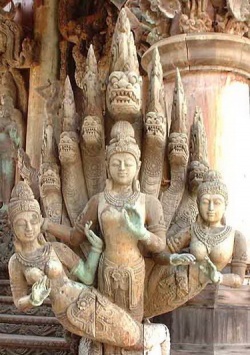Reptilians: Buddhist Naga
Nāgā ("reptilian") is a class of beings classified with garudas ("avian" creatures akin to pterodactyls) and supannas (bird-human chimeras). They play a prominent role in Buddhist folklore. Gifted with miraculous powers and great strength, they are confused with snakes, chiefly the hooded cobra. Indeed, their bodies are described as being those of snakes, but they can assume human form at will. Thus possessing the power of transformation, they are "shape shifters." Broadly they are to be divided into two classes, land-based (thalaja) and water-based (jalaja). The Thalaja-nāgās are regarded as subterranean (and therefore confused with "demons"), whereas the Jalaja-nāgās live in rivers and in the ocean. It would be more correct to view them as dragons and sea-serpents, respectively.
Several dragon-dwellings (Nāgā-bhavana) are mentioned in Buddhist texts, for example:
- Mañjerika-bhavana under Sineru
- Daddara-bhavana at the foot of Mount Daddara in the Himālayas
- Dhatarattha the dragon under the river Yamunā
- Nābhāsā the dragon in Lake Nabhasa
- The Reptilians of Vesāli, Tacchaka, and Payāga (D.ii.258).
The Book of Discipline (Vinaya ii.109) contains a list of four Royal Families of Nāgas (Ahirājakulāni) to be readiated with loving-kindness to avert snake bite and/or to overcome a fatality due to a venomous bite after the fact. These four Royal Reptilian Families are: Virūpakkhā, Erāpathā, Chabyāputtā, and Kanhagotamakā. Two other Nāga tribes are generally mentioned together, the Kambalas and the Assataras. It is said that all Nāgas have their young in the Himālayas (SA.iii.120). Nagaland, a place in India to the extreme east, is a state with a reputedly ferocious human tribes called Nagas.
The World of the Nagas is at the base of Sineru [which research by WQ has determined refers to the north pole and the surrounding sphere regarded by Western science as the atmosphere; see entry on the 31 Planes of Existence).
There are stories -- for example, in the Bhūridatta Jātaka -- of Nāgas, both male and female, mating with humans. Although the offspring of such unions are said to be watery and delicate (J.vi.160), it settles the question of how to translate the term "Naga": it clearly refers in modern parlance to Reptilians. There is a great deal of material on Raja-Nagas, the royal bloodlines of human rulers in many cultures and world governments -- Indian, Chinese, Japanese, German, British, American, and so on. (The topic of modern Reptilian infiltration in government is too broad and well established to be gone into here; reading the widely published works of Zecharia Stitchen or more obscure work by Elliott Hughes can serve as a launchpad into that field).
Reptilians are passionate and easily angered, their breath is poisonous (cf. "fire-breathing" and the curious custom of the largest living reptile, the Komodo Dragon, to simple touch its prey with its septic mouth and wait for it to drop dead of infection or of the deadly African viper that spits its blinding venom at humans from a considerable distance), and their glance can be deadly (J.vi.160, 164). They are carnivorous (J.iii.361), their diet consisting chiefly of frogs (J.vi.169), and they sleep, when in the human world, on ant hills (Ibid., 170). The enmity between the Reptilians and the Avians (Garulas) is proverbial (D.ii.258). At first the, it is said, Avians did not know how to seize Repitilians because the latter swallowed large stones so as to be of great weight. But they learned how in the Pandara Jātaka. The Reptilians dance when music is played. However, it is said (J.vi.191) that they never dance if any Garula is near (through fear) or in the presence of human dancers (through shame).
The best known of all Reptilians is Mahākāla, king of Mañjerika-bhavana (the dragon dwelling under Sineru). He lives for an entire age (Sanskrit kalpa, Pali kappa can refer either to an aeon or a full "life term," which for nagas is either 90,000 or 90 million human years), and is a very pious follower of the Buddha. These are curious statements reminiscent of the anthropologist Michael J. Harner's experience using a Soma (Banisteriopsis, a shaman/psychopharmacological brew of hallucinogenic Amazon plants, whose active psychotropic agent is DMT, among the Jivaro Indians, who refer to it as Natema). He reported the following remarkable similarities to various Buddhist cosmological assertions:
- "...in 1961 I had occasion to drink the hallucinogen in the course of field work with another Upper Amazon Basin tribe. For several hours after drinking the brew, I found myself, although awake, in a world literally beyond my wildest dreams. I met bird-headed people [Garudas/Supannas], as well as dragon-like creatures [Naga-Rajas] who explained that they were the true gods of this world [semi-human rulers, demigods under the reign of Maharaja of the West, Virupakkha, a regent charged with watching over this world). I enlisted the services of other spirit helpers in attempting to fly through the far reaches of the Galaxy [the world-system, Cakkavala, and beyond). Transported into a trance [a functional jhana) where the supernatural seemed natural, I realized that anthropologists, including myself, had profoundly underestimated the importance of [this substance) on native ideology" (Reference: http://deoxy.org/rushingw.htm).
The Reptilians of his world had the custodianship of a part of the Buddha's relics until they were needed for the "Great Pagoda" (Māha Stūpa, Mhv.xxxi.27f.). And when the Bodhi tree was being taken to Sri Lanka, they did it great honor during the voyage (Mbv. p.. 163f.). Other Reptilian kings are also mentioned as ruling with great power and majesty and being converted to the Buddha's teaching -- for example, Aravāla, Apalālā, Erapatta, Nandopananda, and Pannaka. (See also Ahicchatta and Ahināga). In the Atānātiya Sutra (D.iii.198f.), speaking of dwellers of the Realm of the Four Great Sky Kings (Cātummahārajika), Nāgas are mentioned as occupying the Western Quarter, with Virūpakkha as their king.
The Nāgas had two chief settlements in Sri Lanka, in Nāgadīpa (q.v.) and at the mouth of the Kalyānī river. It was to settle a dispute between two Nāga chiefs of Nāgadīpa, Mahodara and Cūlodara, that the Buddha reputedly paid his second visit to Sri Lanka. During that visit he made a promise to another Nāga-king, Manjakkhika of Kalyānī, to pay him a visit. And the Buddha's third visit was in fulfilment of that undertaking (Mhv.i.48f.).
The repitlians form one of the guards set up by Sakka ("king of kings," the reigning monarch over the Four Great Kings as well as the devas in his home world, Tavatimsa) at the base of Sineru against the Asuras (J.i.204). The reptilians were sometimes worshipped by human beings and were offered sacrifices of milk, rice, fish, meat, and strong drink (J.i.497f.) and in more recent times was practiced widely in the decadent period of Angkor's decline in Cambodia (and seems to have been exactly what happened in Mesoamerica with the declining and now extinct Maya and Aztec cultures; modern Mexico, which inherited these cultures, was founded where shamans prophesized a Garuda would be seen defeating and devouring a Naga). The jewel of the Reptilians is famous for its beauty and its power of conferring wishes to its possessor (J.vi.179, 180).
The word "Nāga" is often used as an epithet of the Buddha and the Arhats. In this connection the etymology given is āgum na karotī ti Nāgo (e.g., MNid.201). The Bodhisattva ("Buddha-to-be") was born several times as the King of the Nāgas: Atula, Campeyya, Bhūridatta, Mahādaddara, and Sankhapāla.
In the accounts given, there is undoubtedly great confusion between the Nāgas as supernatural beings (transforming reptilians), as snakes, and as the name of certain non-Aryan human tribes. But the confounding of one with the other is too entangled to unravel.
Reference: Dictionary of Pāli Proper Names (G. P. Malalasekera) Pali Text Society.
Nāga (नाग) and Nāgī (male and female) is the Sanskrit and Pāli word for a minor deva taking the form of a very large serpent in Hindu and Buddhist mythology. The use of the term nāga is often ambiguous, as the word may also refer, in similar contexts, to one of several human tribes known as or nicknamed Nāgas, to elephants, and to ordinary snakes, particularly the king cobra and the Indian cobra, which is still called nāg in Hindi and other Indian languages.
Nagas in Hinduism
Stories involving the Nāgas are still very much a part of contemporary cultural traditions in predominantly Hindu regions of Asia (India, Nepal, Bali, and "Indochina" the fusion cultures between these massive empires). In India, they are considered "nature spirits" and the "protectors" of springs, wells, and rivers. They bring rain, and thus fertility, but are also thought to bring disasters such as floods and drought. According to some traditions they are only malevolent to humans when they have been mistreated. They are susceptible to mankind's disrespectful actions in relation to the environment. Since they have an affinity with water, the entrances to their underground abodes are often said to be hidden at the bottom of wells, deep lakes, and rivers. They are especially popular in southern India where some believe that they bring fertility to their venerators. Some believe that the legends of nāgas may have originated with tribal people in the past.
Varuna, the Vedic god of storms, is viewed as the King of the Nāgas. They live in Pātāla, the seventh of the "nether" dimensions or realms. They are children of Kashyapa and Kadru. Among the prominent Nāgas of Hinduism are Manasa, Shesha or Śeṣa, and Vasuki.
They are also said to carry the elixir of life and immortality. One story mentions that when the demigods (devas) were rationing out the elixir of immortality, the Reptilians grabbed a cup. The demigods were able to retrieve the cup, but in doing so, spilled a few drops on the ground. The reptilians quickly licked up the drops, but in doing so, cut their tongues on the grass, which is a story used to explain why their tongues are forked.
The name of the Indian city Nagpur (Marathi: नागपुर) is derived from Nāgapuram, literally, "city of nāgas."
Nāgas in Buddhism
Traditions about nāgas are also very common in all the Buddhist countries of Asia. In many countries, the nāga concept has been merged with local traditions of large and intelligent serpents or dragons. In Tibet, the nāga was equated with the klu (pronounced lu), spirits that dwell in lakes or underground streams and guard treasure. In China, the nāga was equated with the lóng or Chinese dragon.
The Buddhist nāga generally has the form of a large cobra-like snake, usually with a single head but sometimes with many. At least some of the nāgas are capable of using magic powers to transform themselves into a human semblance. In Buddhist painting, the nāga is sometimes portrayed as a human being with a snake or dragon extending over his head.
Nāgas both live on Mount Sumeru, among the other minor deities, and in various parts of the human-inhabited earth. Some of them are water-dwellers, living in rivers or the ocean; others are earth-dwellers, living in underground caverns. Some of them sleep on top of anthills. Their food includes frogs.
In Buddhism, the nāgas are the enemies of the Garuḍas, minor deities resembling gigantic eagles, who eat them. They learned how to keep from being devoured by the Garuḍas by eating large stones, which made them too heavy to be carried off by the Garuḍas.
The nāgas are ruled by Virūpākṣa (Pāli, Virūpakkha), one of the Four Heavenly Kings who guards the western direction. They act as guardians on Mount Sumeru, protecting the devas of Trāyastriṃśa (Pali, Tavatimsa) from attack by the asuras.
Among the notable nāgas of Buddhist tradition is Mucalinda, who protected the Buddha from a fierce storm by his ability to transform into a large hooded cobra whose hood covered the meditating Buddha.
Nagas in Cambodia
In a Cambodian legend, nāgas were a reptilian race of beings who possessed a large empire or kingdom in the Pacific Ocean region. The Nāga King's daughter (a reptilian) married the king of ancient Cambodia and thus gave rise to the Cambodian people (the Khmer). This is why to this day Cambodians say they are "Born from the Nāga." The Seven-Headed Serpents depicted in Cambodian temple statuary, such as Angkor Wat, apparently represent the seven races within Nāga Society, which has a mythological, or symbolic, association with "the seven colors of the rainbow." Furthermore, Cambodian nāgas possess numerological symbolism in the number of their heads. Odd-headed nāgas symbolize male energy, infinity, timelessness, and immortality. This is because, numerologically, all odd numbers come from one (1). Even-headed nāgas are said to be "female, representing physicality, mortality, temporality, and the earth."
Nagas in Nagaland
The Naga people of Nagaland, India, are said to have believed themselves to be descendants of the mythological "Nāgas", but to have lost this belief due to Christian missionary activity."
Reference: http://en.wikipedia.org/wiki/Naga_(mythology)
Other Naga traditions
For Malay sailors today, nāgas are a type of sea dragon with many heads (and may refer to either giant squid, unestablished dinosaur-like creatures, or cratures with the power of transformation). In Thailand and Java, the naga is a wealthy underworld deity that is very protective of its treasures. In Laos they are beaked water serpents.
Interestingly, non-Asian tribal peoples around the world (Australian, African, and South and Central American natives) are aware of semi-spirit nagas (with the ability to physically manifest) who are associated with rivers and other bodies of water. How they become aware of these water denizens is either by shamanistic practices or by fisherman being directly contacted. And of course there are many Biblical references to dragons, serpents, and human-snakes.
